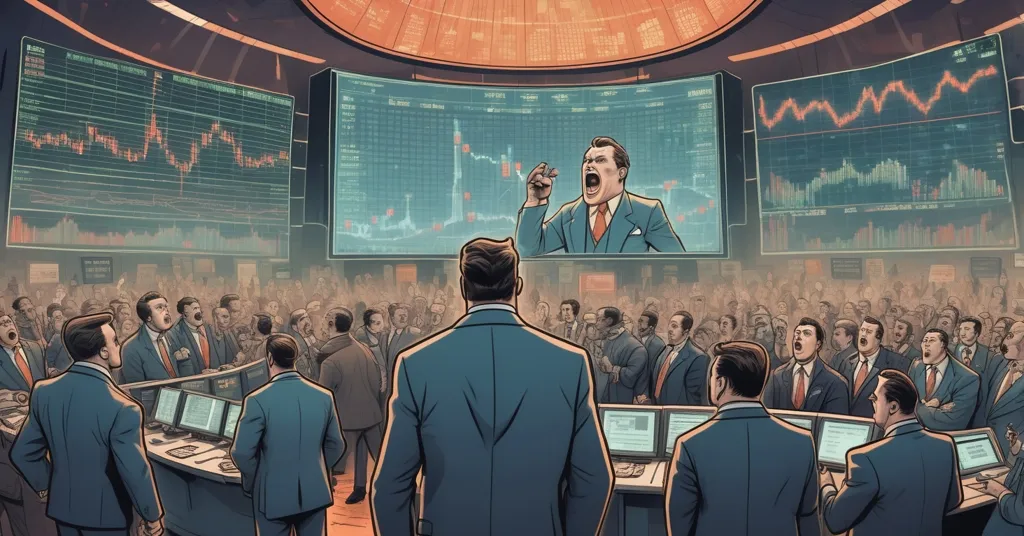Chicago Traders Sue CME for $1B Over Electronic Trading Shift and Bitcoin Futures Impact

Chicago Traders vs. CME: A Billion-Dollar War Over Electronic Trading and Legacy
Chicago’s financial district is about to witness a historic clash as veteran traders of the Chicago Mercantile Exchange (CME) and its subsidiary, the Chicago Board of Trade (CBOT), square off against CME Group in a class action lawsuit starting July 7, 2025. With potential damages north of $1 billion, this battle isn’t just about cash—it’s a raw fight between tradition and technology, with shockwaves that could hit everything from Bitcoin futures to the future of financial markets.
- Trial Start: Set for July 7, 2025, at the Richard J. Daley Center in Chicago.
- Main Grievance: Traders allege CME’s electronic trading shift violated membership rights, causing severe losses.
- High Stakes: A loss for CME could mean over $1 billion in damages and major structural changes.
- Broader Impact: Outcome may ripple into crypto markets and merger plans like with Cboe Global Markets.
The Traders’ Grievance: A Legacy Turned to Dust
Picture this: a bustling trading floor in the heart of Chicago, alive with shouts, hand signals, and the raw energy of open outcry. This was the lifeblood of CME and CBOT traders for decades, where memberships weren’t just tickets to trade—they were golden keys to reduced fees and exclusive access. Many traders inherited these seats as family heirlooms, symbols of pride passed down through generations, tying their bloodlines to Chicago’s financial legacy. But over a decade ago, CME started pulling the plug on this world, shifting to electronic trading and, by 2012, relocating its primary platform to a data center in Aurora, a suburb west of the city. For many, it felt like watching a family butcher shop get bulldozed by a corporate superstore—progress, sure, but at a damn steep personal cost, as detailed in reports about the Aurora data center relocation’s impact on trader memberships.
The financial hit was a body blow. In 2008, a CME membership could command over $1.5 million. Fast forward to April 2025, and that value has plummeted to $700,000. For traders who banked on these assets for their livelihoods or retirement, it’s not just a number—it’s a betrayal. The plaintiffs, a certified class of Class B shareholders and CBOT members, argue that CME broke contractual promises by eroding these benefits without compensation. They’ve lost not only money but also their professional edge in a market now dominated by faceless algorithms. Attorney Steve Morrissey of Susman Godfrey, representing the traders, laid it bare:
“There’s the damage number for the value of the exclusivity right that members haven’t enjoyed for the past decade.”
Morrissey didn’t hold back on CME’s tactics either, accusing them of dragging their feet at every turn:
“They tried to get it dismissed several times, anything they could do to kick the can down the road.”
Beyond the balance sheets, there’s a cultural wound. Chicago’s trading pits were more than workplaces; they were arenas of grit and glory, home to iconic moments like the 1987 Black Monday crash where human traders navigated chaos in real time. These memberships were badges of honor, and seeing them reduced to relics by a server farm in Aurora cuts deep. It’s a story of heritage clashing with cold, hard efficiency—a theme that echoes far beyond Illinois, as captured in discussions about old school traders facing off against CME.
CME’s Counter: Progress Ain’t Pretty, But It Pays
CME isn’t sitting quietly while traders cry foul. Their stance? The world moved on, and so did markets. Electronic trading wasn’t a personal attack; it was a response to demand for speed, scale, and accessibility. Physical pits couldn’t keep up with the volume and efficiency of digital platforms, and by the time Aurora became the hub in 2012, open outcry was already a dying breed. To CME, those old membership perks—like exclusive floor access—were tied to a bygone era, not a server room. Think of it as moving a farmers’ market online: traders want the same VIP treatment in the digital space, but CME insists it’s a whole new game with different rules, a perspective explored in depth in the ongoing electronic trading controversy.
Here’s where CME throws a curveball worth mulling over. While memberships tanked in value, many holders got Class A shares during CME’s shift to a publicly traded entity after the 2007 CBOT acquisition. If they held onto those shares with reinvested dividends, they could be sitting on a fortune—between $17.6 million for CBOT members and $30.7 million for CME members as of mid-2023. That’s not pocket change. Sure, it doesn’t erase the sting of a legacy turned to digital ash, but it suggests some traders might’ve come out ahead if they played their cards right. CME’s argument is clear: disruption sucks for some, but others rode the wave to bigger gains. It’s a harsh reality check in a world obsessed with nostalgia.
Moreover, electronic trading has democratized markets in ways physical floors never could. Lower costs, wider access, and lightning-fast execution have opened doors for smaller players—something CME might argue is the real legacy worth celebrating. It’s not a perfect defense, but it’s a reminder that tech’s march forward often leaves casualties while lifting others up. Sound familiar? It’s the same messy dynamic we see with blockchain shaking up centralized finance.
Legal Showdown: A Jury to Decide the Damage
The stage is set at the Richard J. Daley Center under Cook County Circuit Judge Patrick J. Sherlock, who on April 15, 2025, shut down CME’s attempt to dismiss the case. His reasoning was straightforward—there are too many unresolved questions for a quick ruling. As he put it:
“The Court found an issue of disputed fact concerning almost every point defendants made in their brief in support of summary judgment.”
While acknowledging CME has a “defensible case,” Sherlock insisted the traders’ evidence demands a jury’s verdict. One sticking point is whether the Aurora data center counts as a “trading floor” where membership perks should still apply. Traders say it’s the modern equivalent; CME says no dice. If the jury sides with the plaintiffs, CME could be on the hook for over $1 billion, a figure reflecting years of lost privileges and devalued assets since digital platforms took over. That’s not just a payout—it’s a potential restructuring of how exchanges handle historical obligations in a tech-driven age, with insights available in this detailed overview of the CME lawsuit.
Both sides are dug in, and this isn’t a simple David-versus-Goliath tale. The traders have a compelling emotional case, but CME’s logic about market evolution isn’t baseless. A full-blown trial could turn into a legal quagmire from hell, with every contract clause and historical promise dissected. There’s talk of mediation as a less brutal path, but with egos and a billion bucks on the line, don’t bet on a quick handshake. For a deeper dive into the potential financial fallout, check this expert analysis on damages over $1 billion.
Crypto Connection: Bitcoin Futures in the Crosshairs
While Chicago’s courtroom drama heats up, the shockwaves could rattle far beyond trading pits into the wild west of cryptocurrency markets. CME isn’t just a relic of traditional finance; it’s a heavyweight in crypto, pioneering Bitcoin futures since 2017 and later adding XRP futures. For the uninitiated, futures are contracts to buy or sell an asset—like Bitcoin—at a fixed price on a later date, a tool for hedging risk or betting on price swings. These products have been a gateway for institutional players to dip into crypto without holding actual coins, bridging old money with new tech, though some question their broader impact as discussed on how Bitcoin futures influence prices.
A ruling against CME could mess with this setup. If membership benefits get redefined or fees rejigged to cover damages, crypto traders using CME’s platforms might face higher costs or tighter access. Imagine a hedge fund paying more to speculate on Bitcoin’s next move—those costs trickle down, potentially cooling institutional appetite. Worse, a billion-dollar hit might make CME skittish about rolling out new crypto derivatives, slowing mainstream adoption at a time when blockchain tech is hungry for legitimacy. For Bitcoin maximalists like myself, it’s a double-edged sword: CME’s centralized grip on futures is already a compromise, but it’s also a pipeline for normies to get exposure. Disrupt that, and you risk stunting growth, a concern highlighted in analyses of the lawsuit’s impact on Bitcoin futures markets.
Here’s a spicier take—could this lawsuit inadvertently boost truly decentralized exchanges (DEXs)? If CME stumbles, traders might flock to platforms where no legacy giant calls the shots, accelerating the peer-to-peer future we’re all rooting for. It’s a long shot, but tech’s domino effect is real. Just as electronic trading sidelined human brokers, Bitcoin and blockchain are sidelining banks. CME’s caught in the middle, and how they navigate this storm could shape crypto’s integration into the financial mainstream.
What Happens Next: Trial, Settlement, or Ripple Effect?
As July 7, 2025, looms, all eyes are on Chicago. A jury verdict could send shockwaves far beyond the city’s borders, forcing exchanges worldwide to rethink how they balance innovation with historical promises. If CME loses, expect a scramble to revise trading access and membership structures, not to mention a possible chill on merger talks with players like Cboe Global Markets. A settlement might be the smarter play—patch up the wounds without torching CME’s reputation or draining its coffers—but with both sides itching for a fight, compromise feels like a distant dream. Community perspectives on this clash can be found in various online discussions about the lawsuit.
Zoom out, and this spat is a microcosm of finance’s eternal tug-of-war between yesterday and tomorrow. It’s the same struggle we see in crypto’s battle against centralized control, where every step forward ruffles feathers. Will Chicago’s traders be the last stand against tech’s relentless takeover, or just the first skirmish in a broader digital war? One thing’s for sure: the outcome will set a precedent for how markets handle disruption, whether it’s algorithms replacing humans or blockchain replacing banks. For more comprehensive updates, refer to coverage on the CME Group class action lawsuit details.
Key Takeaways and Burning Questions
- What’s driving the CME lawsuit?
Traders claim CME’s pivot to electronic trading and the 2012 Aurora data center move gutted their membership rights, slashing asset values and causing professional damage. - Why do memberships mean more than money to traders?
Many see them as “family legacies,” heirlooms tying generations to Chicago’s storied trading history, making the loss deeply personal. - How might this affect Bitcoin and crypto markets?
A CME loss could hike fees or restrict access to Bitcoin and XRP futures, impacting crypto traders and potentially slowing institutional adoption. - What’s CME’s defense against the outrage?
They argue electronic trading was inevitable, and Class A shares worth millions today offset membership devaluation for some, showing not everyone lost out. - Could this derail CME’s bigger plans?
Absolutely—a defeat might stall mergers like with Cboe Global Markets and force pricey overhauls of trading access policies. - Does this mirror blockchain’s disruption?
Damn right it does. Just as CME’s digital shift upended traders, Bitcoin and decentralized systems are upending traditional finance, proving tech’s march spares no one.
So, as the gavel drops in Chicago, the stakes couldn’t be higher. A billion dollars, a city’s financial soul, and a blueprint for market evolution hang in the balance. Whether you’re a Bitcoin diehard cheering every crack in centralized systems or a pragmatist tracking CME’s role in crypto futures, this fight matters. It’s tradition versus tech, human grit versus cold code. Who blinks first? We’ll be watching.



